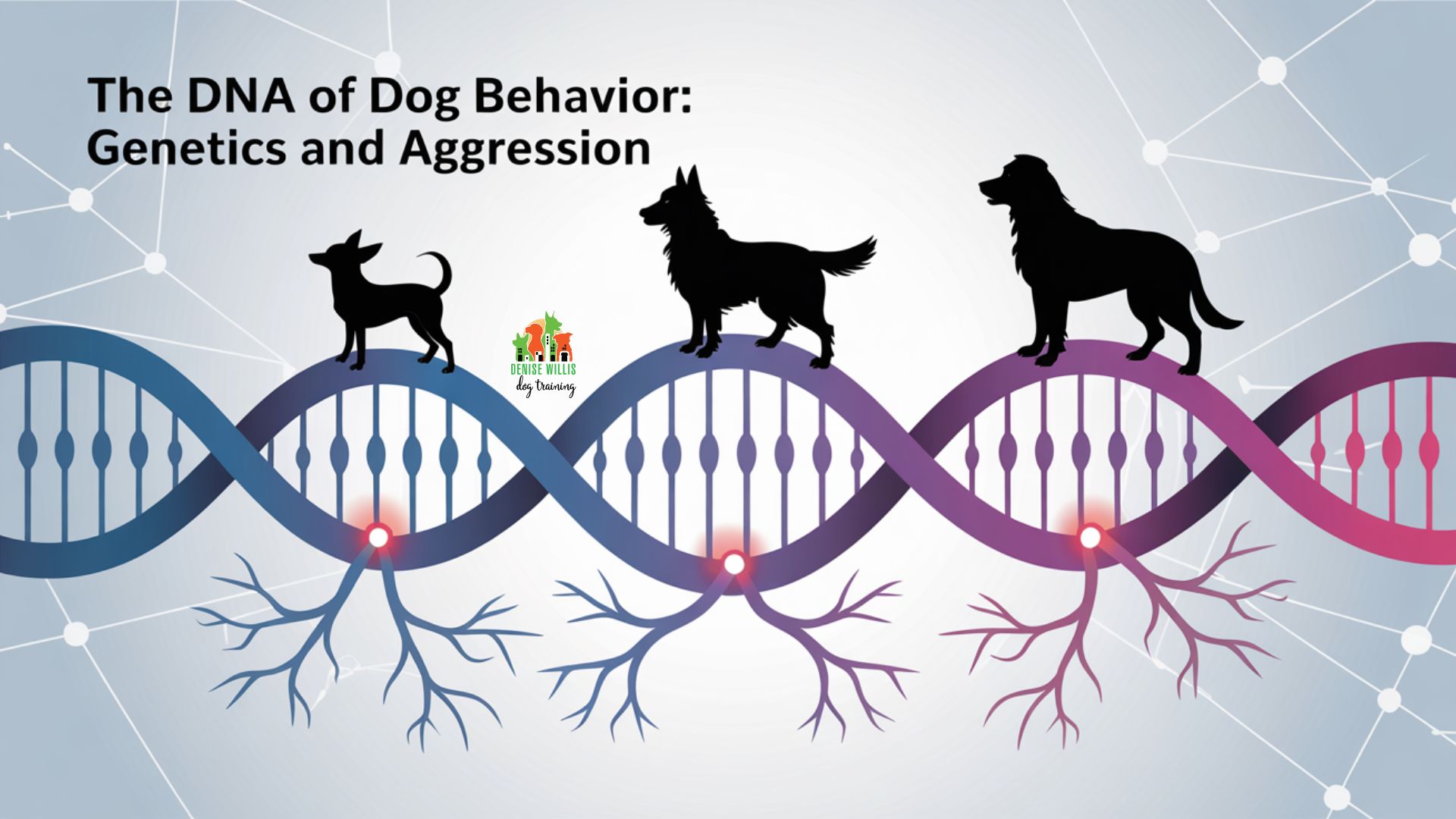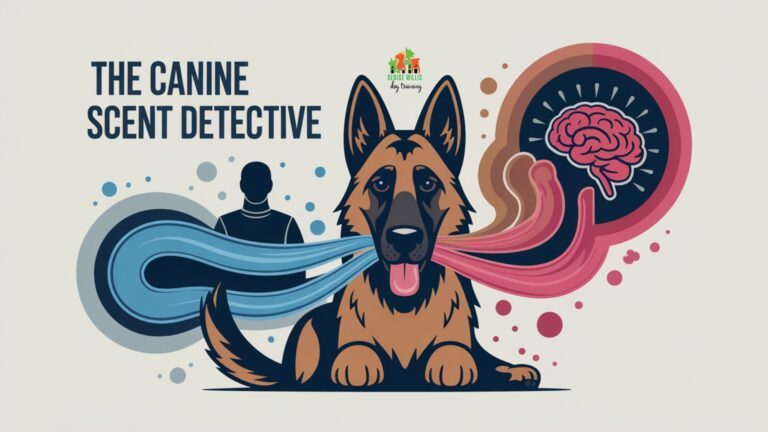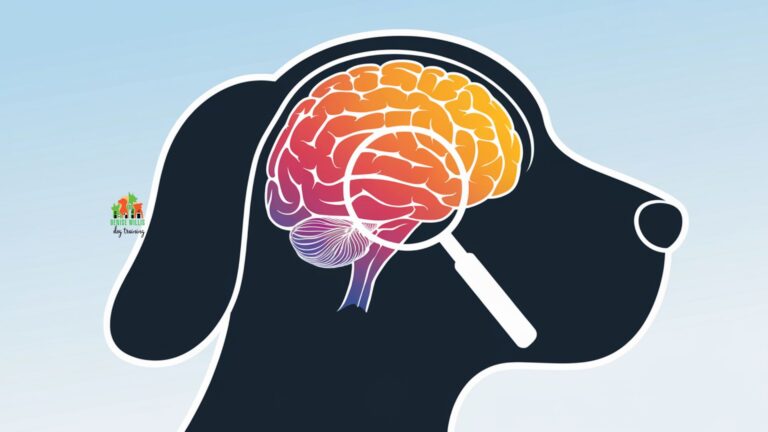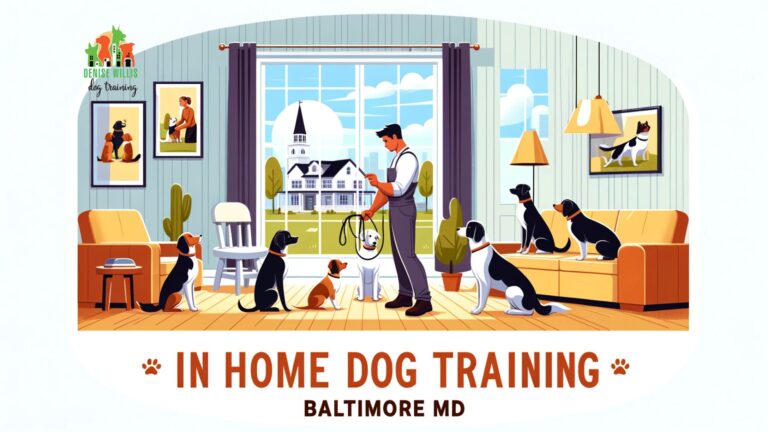Nature vs. Nurture: The Genetic Factors Behind Dog Aggression
📍 Service Area Notice: DW Dog Training provides in-person training services exclusively in the Greater Baltimore area. While our blog content is designed to help dog owners internationally, our hands-on training services are locally focused. For readers outside our service area, we hope you find value in our articles and welcome you to reach out with questions!
Ever wondered why your neighbor’s adorably fluffy Chihuahua seems determined to conquer the world one ankle bite at a time, while your imposing Rottweiler prefers to be a gentle giant?
Is it all in how they were raised, or did they come pre-programmed with these personality traits?
Genetics and dog aggression represent one of the most fascinating and misunderstood aspects of canine behavior. The age-old nature versus nurture debate takes on a whole new dimension when we’re talking about our four-legged companions. Recent research reveals that your dog’s DNA might have more to say about their tendency to growl at strangers than we previously thought, though it’s definitely not the whole story.
Key Takeaways
- Genetic Foundation: Scientific studies reveal that genetics accounts for a whopping 60-70% of variations in dog aggression, though environment still plays a crucial role
- Gene Superstars: Specific genes like DRD1 (dopamine), HTR1D (serotonin), and SLC6A1 (GABA) have been caught red-handed influencing aggressive behavior
- Breed Reality Check: While certain breeds may have genetic predispositions, individual dogs vary tremendously within breeds
- Hormonal Hijinks: Intact males often show more aggression thanks to testosterone’s influence on genetic expression
- Management Magic: Understanding your dog’s genetic background enables more targeted and effective training approaches
- Environmental Edge: Good news! Proper training and socialization can substantially modify even genetically-influenced behavior
- Individual Assessment: Your dog is more than their breed label, individual evaluation beats stereotyping every time
The Genetic Factors Behind Dog Aggression
Genetic Foundation
Research shows 60-70% of variations in dog aggression are attributable to genetics, with specific genes like DRD1 (dopamine) and HTR1D (serotonin) directly influencing behavior.
Breed Differences
While no breed is inherently “dangerous,” research shows breed-specific genetic tendencies exist. Surprisingly, small breeds like Chihuahuas often score higher on certain aggression metrics than larger breeds.
Neuroscience Factors
Brain structure and neurochemistry are genetically influenced, with variations in amygdala size and neurotransmitter pathways creating predispositions toward certain responses to triggers.
Environment & Epigenetics
Environmental factors like early socialization, training methods, and life experiences can modify how genetic predispositions are expressed through epigenetic changes to gene function.
The Science of Canine Aggression Genetics
Have you ever met a dog that seemed born ready to argue with the world? Turns out, there might be some truth to that impression. The scientific community has been digging deeper into doggy DNA, and what they’re finding is both fascinating and practical for anyone who lives with or works with our canine companions.
Research utilizing the Canine Behavioral Assessment and Research Questionnaire (C-BARQ), essentially a massive personality test for dogs, has consistently shown heritability estimates of 60-70% for various forms of aggression.
In plain English?
A significant chunk of your dog’s tendency to growl, snap, or bite comes from their genetic blueprint rather than just their upbringing or training history. According to a comprehensive study by Zapletal and colleagues, when they analyzed over 17,000 dogs, the genetic component of aggression was surprisingly strong.
Think of it like this: genetics loads the gun, but environment pulls the trigger. Your German Shepherd might come with genetic coding that makes them more likely to be protective, but whether that manifests as appropriate alertness or problematic aggression depends heavily on training, socialization, and life experiences.
Genome-wide association studies have identified specific regions on dog chromosomes linked to different types of aggression. These aren’t simple “aggression genes”, instead, they’re complex genetic networks that influence brain development, neurotransmitter function, and stress responses. Modern genetic testing can now identify certain risk markers, giving breeders and owners valuable insights into potential behavioral tendencies before they become problems.
Neurotransmitters and Genetic Pathways
If your dog’s brain chemistry was visible, you might see a fascinating light show of neurotransmitters, chemical messengers that influence everything from mood to impulse control. The genes controlling these neurotransmitters play a starring role in the aggression story.
Dopamine pathway genes, particularly DRD1 and SLC6A3 (the dopamine transporter gene), significantly impact reward-seeking behavior and impulse control. Think of dopamine as your dog’s “motivation molecule”, when these systems go haywire, impulsive aggression can result. A fascinating example comes from Belgian Malinois, where researchers identified a specific variant (A22) in the SLC6A3 gene that correlates with sudden, unpredictable aggressive outbursts. These aren’t dogs being “bad”, they’re experiencing the equivalent of a neurological short circuit.
Serotonin pathway genes, including HTR1D and HTR2C, are the mood regulators of your dog’s brain. Just like in humans, lower serotonin levels often correlate with increased irritability and aggression. When these genes don’t function optimally, your dog may struggle with emotional regulation. It’s the canine equivalent of waking up on the wrong side of the bed… every single day.
GABA pathway genes like SLC6A1 act as your dog’s natural tranquilizers, putting the brakes on excessive neural activity and stress responses. When these systems are compromised through genetic variations, anxiety and fear-based aggression become more likely. Picture a car with faulty brakes, things can get scary fast.
Perhaps most fascinating is the oxytocin receptor gene (OXTR), sometimes called the “love hormone” gene. Variations here influence your dog’s ability to form social attachments and read social cues. Research by Kis and colleagues found that mutations in this gene can affect how dogs bond with humans and other dogs, potentially impacting social aggression.
Breed-Specific Genetic Predispositions
“It’s all how you raise them” might be the battle cry of breed advocates everywhere, but science suggests a more nuanced reality. Certain breeds do carry genetic tendencies toward specific behavioral traits, including various forms of aggression. This doesn’t mean these dogs are “bad” or dangerous; it simply means owners and trainers need awareness and appropriate management strategies.
Historical selection for specific working functions has left genetic fingerprints on modern breeds. Guard dogs like Rottweilers and German Shepherds were selectively bred for protective behavior, territorial awareness, and appropriate suspicion of strangers. These traits served vital functions in their working roles but can manifest as stranger-directed aggression without proper socialization and training.
Terriers, bred to hunt and kill vermin independently, often show higher prey drive and can be more reactive. The fascinating study by Zapetal et al. found that terriers as a group tend to show more dog-directed aggression than other breed groups, likely due to their historical selection for independence and tenacity.
Surprisingly, some of the breeds with the highest scores for certain types of aggression aren’t the ones typically portrayed as “dangerous.” Multiple studies have found that smaller breeds like Chihuahuas and Dachshunds often score higher on owner-directed aggression than larger breeds. Their bites may cause less damage, but their genetic predisposition toward reactive behavior is very real.
The key point here isn’t to stigmatize any breed but to recognize that different genetic backgrounds may require different training approaches. A Border Collie’s intense focus and energy needs different management than a Great Pyrenees’ independent guardian instincts, which differ from a Beagle’s scent-driven persistence.
Timeline of Dog Development and Aggression Risk Factors
0–2 Weeks: Neonatal Period
During this earliest stage of development, puppies are primarily influenced by their mother. Their focus is entirely on survival and developing basic senses.
There is no aggression risk during this period as puppies are completely dependent and lack the physical or cognitive ability to display aggressive behaviors.
2–4 Weeks: Transitional Period
Puppies begin interacting with their littermates during this transitional stage. Early social bonds start forming as they become more aware of their environment.
These initial social interactions help establish the foundations for appropriate play behavior and early bite inhibition learning.
3–12 Weeks: Socialization Period
Critical window for socialization and learning bite inhibition.
During this critical period, puppies learn to interact appropriately with people and other dogs. The experiences they have during this time will significantly shape their future behavior patterns.
Research shows that lack of positive exposure to different stimuli or experiencing traumatic events during this period can substantially increase the risk for fear-based aggression later in life.
8–11 Weeks: Fear Imprint Period
Puppies are especially sensitive to frightening experiences during this developmental stage.
Negative or traumatic events experienced during this time can lead to lifelong fear or aggression if not properly addressed. This period overlaps with the socialization window, making it a particularly crucial time for careful exposure to new stimuli.
3–6 Months: Ranking Period
Puppies begin to test boundaries and explore social ranking with humans and other animals as they grow more independent.
During this period, early signs of resource guarding or possessive aggression may appear. This is an important time for consistent training and establishing clear boundaries to prevent later behavioral issues.
6–18 Months: Adolescence
High-risk period for new aggressive behaviors to emerge
Dogs become more independent during adolescence and may challenge authority. Hormonal changes (especially in intact males) can increase territorial and protective behaviors.
This is a common time for the first signs of objectionable or problematic aggression to emerge, especially if a genetic predisposition exists. Consistent training and adequate supervision are particularly important during this stage.
8–9 Months: “Teenage” Phase
A surge in hormones occurs during this phase; males may start marking territory, and females may enter their first heat cycle.
Protective and territorial instincts intensify during this period. Some dogs may begin barking at strangers or guarding property. Aggressive behaviors—if genetically predisposed—may become more apparent and require prompt intervention.
1–2 Years: Social Maturity
Most dogs reach behavioral adulthood during this period, with fully developed temperaments and behavior patterns.
Aggression related to genetics (such as “Rage Syndrome” or conflict aggression) may become fully apparent. Dogs with underlying genetic disorders may display unpredictable, intense episodes of aggression that seem to occur without clear triggers.
Throughout Adulthood
Aggression can be triggered or exacerbated by specific situations throughout a dog’s adult life, including resource guarding, handling sensitivities, or perceived invasion of space.
Most dogs provide warning signs (growling, baring teeth, freezing) before escalating to biting, but some genetically predisposed dogs may “skip” warnings or have rapid escalation from seeming calm to aggressive behavior.
Key Takeaways for Dog Owners
- Early socialization (3–12 weeks) is crucial for preventing aggression, especially in genetically predisposed breeds.
- Adolescence (6–18 months) is a high-risk period for new aggressive behaviors to emerge—consistent training and supervision are vital.
- Warning signs often precede aggression; learn to recognize body language to prevent incidents.
- Genetic disorders (like Rage Syndrome) may manifest as sudden, unpredictable aggression, often during social maturity.
Within-Breed Variation: Individual Genetics Matter
While breed tendencies exist, the variation within breeds is enormous. You’ve probably met the shy German Shepherd and the outgoing Chow Chow that completely buck their breed stereotypes. This wide range of personalities within breeds happens partly because modern breeds are genetically diverse despite their similar appearances.
Research published in Science analyzed the genomes and behavior of over 2,000 dogs and found that while breeds do show some behavioral tendencies, individual genetic makeup is a much stronger predictor of behavior than breed alone. In fact, breed accounts for only about 9% of behavioral variation between individual dogs.
What does this mean for you and your protective pooch? While understanding breed tendencies provides useful general information, your individual dog’s genetic makeup is unique. The Australian Shepherd who cowers during thunderstorms and the Labrador who guards their food bowl aren’t “broken” versions of their breeds, they’re individuals with their own genetic and environmental influences.
Understanding the Research: What the Numbers Tell Us About Canine Aggression
After exploring the genetic foundations of dog aggression, it’s important to look at what the research actually shows. Statistics help us understand just how prevalent aggressive behaviors are and which factors might influence your dog’s likelihood of showing aggression.
The Scope of Dog Aggression
The raw numbers reveal why understanding dog aggression matters for both public safety and the welfare of our canine companions.
| Finding | Impact | Notes | Source |
|---|---|---|---|
| Annual dog bites | 4.5 million | Over 800,000 people require medical attention annually | [1] |
| Children at risk | More than 50% | Children account for over half of all dog bite victims | [5] |
| Daily emergency cases | 1,000 people | Approximately 1,000 people require emergency care daily for serious dog bite injuries | [1] |
| Insurance impact | $1.1 billion | Dog bite-related insurance claims exceeded $1.1 billion in 2023 | [1] |
These figures highlight the significant impact dog bites have on public health and safety, emphasizing why learning about the factors that contribute to aggression is so important for responsible dog ownership.
Breed Patterns and Individual Differences
While genetics certainly play a role in aggression tendencies, the research shows interesting patterns across different breeds and types of dogs.
| Finding | Percentage | Notes | Source |
|---|---|---|---|
| Dogs showing aggression | 55.6% | Dogs display moderate-to-serious aggression in at least two scenarios | [3] |
| Breed variations | Variable | Collies, Poodles, Schnauzers, and German Shepherds show higher odds of aggression | [4] |
| Small breed aggression | Higher rates | Dachshunds, Chihuahuas, Jack Russell Terriers exhibit higher rates of aggression | [4] |
| Dog-directed aggression | Over 20% | More than 20% of Akitas, Jack Russells, and Pit Bulls display serious aggression toward unfamiliar dogs | [4] |
Notice how these statistics challenge some common assumptions about which dogs might be more aggressive. The data shows that small breeds often display higher rates of certain types of aggression than some larger breeds with more intimidating reputations.
Beyond Genetics: Environmental Influences
A dog’s surroundings and living situation significantly impact their behavior patterns, including aggression.
| Factor | Impact | Notes | Source |
|---|---|---|---|
| Sex and age | Higher risk | Male dogs and older dogs are statistically more likely to display aggressive behavior | [2] |
| Fear factor | 5x higher odds | Fearful dogs have over five times higher odds of aggressive behavior compared to non-fearful dogs | [2] |
| Household composition | Higher risk | Dogs in single-dog households are more likely to behave aggressively toward their owners | [2] |
| Location | Higher risk | Aggression is more prevalent in dogs living in rural areas compared to urban environments | [2] |
These environmental factors demonstrate how a dog’s life context can either trigger or prevent aggressive responses, showing that genetics is just one piece of the puzzle.
The Human Element: How We Shape Our Dogs
Our relationship with our dogs, our experience level, and our training approaches dramatically influence their behavioral development.
| Factor | Impact | Notes | Source |
|---|---|---|---|
| Owner experience | Higher risk | First-time dog owners are more likely to report aggressive behavior in their dogs | [2] |
| Early weaning | Higher risk | Dogs weaned too early show higher odds of developing aggressive behaviors | [2] |
| Owner interaction | Higher risk | Less time spent with owners is associated with higher odds of aggressive behavior | [2] |
| Training methods | Variable impact | Positive reinforcement methods reduce aggression while punishment-based methods can increase it | [18] |
These statistics highlight the critical role that we as dog owners play in either preventing or unintentionally encouraging aggressive behaviors.
Understanding these statistical patterns gives us a clearer picture of the complex interplay between genetics and environment in shaping dog behavior. In the following sections, we’ll explore how brain structure, hormones, and other biological factors interact with these environmental influences.
Influence of Sex, Age, and Physical Traits
Biology brings more variables to the aggression equation beyond just breed and specific genes. Have you noticed how adolescent male dogs sometimes seem to be looking for trouble? Or how that sweet puppy suddenly developed a protective streak after turning two? These patterns aren’t coincidences, they’re biology at work.
Intact (non-neutered) male dogs typically show higher rates of certain types of aggression, particularly toward other male dogs. This isn’t just about training, it’s testosterone talking. This hormone interacts with genetic pathways, essentially turning up the volume on territorially and status-related aggression. Studies have consistently found that neutering reduces aggression in many, though not all, male dogs.
Female dogs have their own hormonal influences on aggression. Maternal aggression, where a mother dog fiercely protects her puppies, has strong genetic and hormonal components. Some female dogs may also show cyclical changes in reactivity related to their reproductive cycles.
Age brings predictable patterns in aggression expression. Puppies rarely show serious aggression. The adolescent period (roughly 6-18 months) often brings the first signs of genetically influenced aggression as the brain develops and hormones surge. Many dogs show increased aggressive tendencies during social maturity (1-3 years), followed by a gradual mellowing with age.
Interestingly, some physical traits correlate with behavioral tendencies. The classic example comes from English Cocker Spaniels, where golden/red-colored dogs show statistically higher rates of aggression than particolored or black dogs. This isn’t because the color itself causes aggression, but because the genes for coat color sit near genes affecting temperament on the chromosome, creating a linked inheritance pattern.
Brain Structure and Function
Your dog’s brain isn’t just influenced by genetics, it’s shaped by them. Brain structure, neural connectivity patterns, and neurochemical functioning all have genetic components that can predispose some dogs toward aggressive responses.
The amygdala, your dog’s emotional processing center, varies in size and reactivity partly due to genetic factors. Dogs with certain genetic profiles may have amygdalae that react more strongly to threatening stimuli, triggering stronger fear or defensive responses. Meanwhile, the prefrontal cortex, responsible for impulse control and decision-making, develops differently based partly on genetic programming, affecting a dog’s ability to inhibit aggressive impulses.
Even brain chemistry has genetic roots. Research has found that dogs with certain genetic profiles have different baseline levels of stress hormones like cortisol and different stress response patterns. These variations can significantly impact how quickly a dog moves from calm to aggressive when faced with a trigger.
Environmental Factors That Modify Genetic Expression
Now for the really good news: genes aren’t destiny. Environmental factors can dramatically influence how genetic tendencies express themselves, and this is where training, socialization, and lifestyle make their grand entrance.
Early socialization during the critical period (roughly 3-14 weeks) can significantly impact how genetic predispositions manifest later in life. Puppies exposed to diverse people, animals, and environments during this window develop more flexible neural pathways and stress response systems. Even dogs with genetic risk factors for aggression can develop into stable, social adults with appropriate early experiences.
Training methods matter enormously when working with genetically predisposed dogs. A study by Herron and colleagues found that punishment-based training methods increased aggression in many dogs, while positive reinforcement reduced it. For dogs with genetic tendencies toward reactivity or aggression, positive methods aren’t just kinder, they’re more effective, working with the dog’s biology rather than against it.
Traumatic experiences can trigger genetic predispositions that might otherwise have remained dormant. A dog with genetic risk factors for fear-based aggression might never show problematic behavior in a stable, positive environment, but could develop serious aggression after a frightening encounter or period of neglect. This explains why genetically similar dogs can show dramatically different behavioral outcomes.
Consistency in handling and environment provides stability that helps management of genetic tendencies. Dogs with genetic predispositions toward anxiety or reactivity often thrive with predictable routines and clear boundaries. This environmental management helps keep stress hormones regulated, reducing the likelihood of aggression.
Epigenetics: Where Nature Meets Nurture
Ready for some mind-bending science?
The field of epigenetics reveals that experiences can actually modify how genes are expressed without changing the underlying DNA sequence. This is where the nature versus nurture debate gets really interesting for dog owners.
Epigenetic changes occur when environmental factors cause chemical modifications that control which genes get turned on or off. Think of it as highlighted text in the genetic instruction manual. Studies in both humans and animals have shown that early life experiences, stress levels, nutrition, and even maternal care can cause epigenetic changes that affect behavior, including aggression.
For dogs, this means that early experiences and training can literally change how their genes function. A puppy with genetic risk factors for aggression who receives excellent socialization, positive experiences, and appropriate training may never express those aggressive tendencies because the relevant genes remain “turned down” epigenetically.
Even more fascinating is the evidence that some epigenetic changes can be passed to future generations. A female dog who experiences high stress during pregnancy may pass certain epigenetic markers to her puppies, potentially affecting their stress responses and behavior. This helps explain why puppies from puppy mills or stressed mother dogs often show more behavioral issues, even when removed from the mother at an early age.
The practical takeaway?
Your training and management choices aren’t just teaching behaviors, they’re potentially influencing gene expression. This powerful concept gives hope for even genetically predisposed dogs and emphasizes the critical importance of positive environments, especially during developmental periods.
Practical Applications for Dog Owners
So, what does all this genetic science mean for you and your four-legged friend? Plenty! Understanding the genetic influences on your dog’s behavior opens up more effective management and training approaches.
Breed research provides useful general information about what to expect, but remember that individual variation is enormous. If you’re considering adding a dog to your family, learn about breed tendencies but don’t make assumptions about any individual dog based solely on breed. A Malinois from working lines will likely have different genetic tendencies than one bred for shows, and individual assessment is always more valuable than breed stereotypes.
Genetic testing for behavior is in its infancy but advancing rapidly. Companies now offer tests that screen for specific mutations linked to behaviors like compulsive disorders and certain types of aggression. While not definitive predictors, these tests can provide useful information, especially for breeders trying to reduce aggression in their lines.
Early intervention is crucial for dogs with genetic predispositions toward aggression. Don’t wait for a bite to occur before addressing warning signs like growling, stiffening, or resource guarding. Genetic tendencies often become more pronounced during adolescence (6-18 months), so this is a critical time for training and management.
Training approaches should be tailored to your dog’s genetic makeup. Dogs with high arousal and reactivity often benefit from impulse control exercises, relaxation protocols, and clear boundaries. Those with fear-based tendencies need confidence-building and positive exposure. Understanding your dog’s genetic predispositions helps you choose the most effective approaches.
Management strategies can prevent genetic tendencies from becoming problematic behaviors. If your dog shows genetic predispositions toward stranger aggression, controlled introductions and appropriate boundaries will be more effective than forcing interactions and hoping for the best. Good management keeps everyone safe while you work on training.
Professional Training Approaches for Genetically Predisposed Dogs
When working with dogs who have genetic predispositions toward aggression, professional guidance can make an enormous difference. The right training approach can modify even strong genetic tendencies, while the wrong approach can make them worse.
A thorough behavioral assessment is the essential first step. Professional trainers and behaviorists evaluate not just the aggressive behaviors themselves but the contexts, triggers, warning signals, and patterns. This helps distinguish between fear-based aggression (often rooted in genetics affecting the amygdala and stress response) and other types like resource guarding or territorial aggression (which have different genetic components).
Counter-conditioning and desensitization protocols work directly with the brain’s learning and emotional systems to change responses to triggers. These science-based approaches gradually pair triggers with positive experiences, literally rewiring neural pathways. For genetically predisposed dogs, these protocols may need to be more gradual and consistent, but they can create lasting change.
Behavioral medication sometimes plays a role when genetic factors strongly influence brain chemistry. Just as we wouldn’t expect someone with genetically influenced depression to “train their way out of it” without considering medication, some dogs benefit from pharmaceutical support along with behavior modification. Medications affecting serotonin, dopamine, or GABA systems can help balance genetically influenced neurochemistry.
Management strategies are particularly important for dogs with strong genetic predispositions. These might include muzzle training (using comfortable basket muzzles for safety), environmental modifications to reduce triggers, structured routines to minimize stress, and clear communication systems between dog and handler.
Consistency across environments and handlers makes an enormous difference for genetically predisposed dogs. When everyone in the household follows the same protocols and boundaries, these dogs can develop reliable, predictable behavior patterns despite their genetic tendencies toward reactivity.
Product Recommendations
The joys of shopping for a dog with genetic tendencies toward protective behavior! It’s like preparing for a four-legged superhero who thinks every delivery person is a supervillain. We’ve assembled a collection of gadgets that would make even Batman’s utility belt jealous.
- ThunderShirt Classic Dog Anxiety Jacket: Is your genetically anxious pup auditioning for the role of “Fun Police” at the local park? Wrap them in this snug jacket and watch them transform from Captain America to Bruce Banner. The gentle pressure activates oxytocin pathways, helping counteract genetic predispositions toward anxiety and reactivity. Warning: May cause your dog to believe they’re being hugged by a very persistent octopus.
- PetSafe Gentle Leader Head Collar: Turn your four-legged bodyguard with those overactive defensive genes into a perfect gentleman with this headcollar. It’s like a steering wheel for your dog, providing gentle control over a genetically strong-willed canine, minus the horn and airbags. Caution: Your dog may temporarily believe they’ve joined a secret dog society where everyone wears fancy face accessories.
- Outward Hound Nina Ottosson Dog Brick Puzzle Toy: Mental stimulation is crucial for dogs with genetic predispositions toward working behaviors. Keep your canine Sherlock Holmes busy with this interactive puzzle that engages problem-solving pathways in the brain. It’s like “Escape Room: Doggy Edition,” but with treats instead of clues. Warning: May turn your dog into a treat-finding savant who starts solving your Sudoku puzzles.
- KONG Classic Dog Toy: The Swiss Army knife of dog toys, perfect for redirecting your pup’s genetically influenced protective instincts. It’s like a chew toy, puzzle, and stress ball all rolled into one rubber cone of joy, providing appropriate outlets for dogs with genetic tendencies toward higher arousal and energy levels. Caution: Your dog may start expecting you to stuff their entire dinner into this magical red cone.
- Zesty Paws Calming Bites for Dogs: These chewable supplements contain ingredients like L-theanine and chamomile that help balance those genetically hyperactive neurotransmitters. Think of them as tiny Zen masters in treat form, bringing harmony to your dog’s genetically anxious mind. Warning: Your dog may develop a sophisticated palate and start judging your own stress-eating habits.
- Treat Pouch: The ultimate fashion accessory for the genetic-savvy dog owner. This handy pouch keeps rewards accessible for those critical moments when you need to counter-condition a genetically influenced reaction. It’s like carrying around a behavior modification lab on your hip. Caution: May cause you to unconsciously reach for treats during human conversations, especially when someone does something you approve of.
- Zuke’s Mini Naturals Training Dog Treats: These tiny treats are perfect for rewarding good behavior and counter-conditioning genetic tendencies toward reactivity. They’re like doggy cryptocurrencies, small, valuable, and your dog will do anything to get more, making them perfect for intensive training protocols. Caution: Your dog may start expecting these for every minor achievement, like successfully napping or heroically guarding against the evil mailman.
Remember, while these products won’t turn your genetically predisposed pooch into a zen master overnight, they’ll certainly make the journey more fun.
And who knows?
With enough puzzle toys and treats, your dog might just decide that being a loving pet is a much better gig than being an overzealous bodyguard.
Further Reading on Canine Genetics and Behavior
Ready to dive deeper into the fascinating world of doggy DNA and behavior?
Consider this your literary leash to guide you through the complex terrain of canine genetics. Warning: Side effects may include spontaneous tail-wagging and an irresistible urge to say “Who’s a good boy?” when reading scientific papers.
- Dog Aggression Solutions: A Complete Guide to Stopping Aggressive Behavior in Dogs: Think your dog’s just smiling with extra teeth? Think again! This article breaks down the whole aggressive behavior conundrum and offers practical solutions without requiring a PhD in canine psychology. Discover step-by-step approaches that transform growls into tail wags, all explained in language that won’t make your brain hurt.
- Causes of Dog Aggression: A Revealing Exploration: Ever wish your dog came with an instruction manual explaining why they sometimes turn into Cujo? This guide is the next best thing! Learn what’s really happening in your dog’s brain when they go from cuddle bug to canine crusader in 0.5 seconds. Caution: May result in you unconsciously psychoanalyzing your friends’ dogs at social gatherings.
- Signs of Aggression in Dogs: How to Identify and Respond: Is your dog showing subtle warning signs that you’re completely missing? This article helps you become fluent in canine body language before things escalate. Includes tips on telling the difference between “I’m uncomfortable” and “I’m about to redecorate your pants leg with my teeth.”
- Dog Aggression in Specific Breeds: Transform your understanding of breed-related aggression with this exploration of how genetics influences different dog breeds. The balanced approach will have you rethinking those breed stereotypes and recognizing the complex interplay of genes and environment. Warning: Your friends may start asking you for breed recommendations once they realize you’ve become a canine genetic profiler.
- Hormonal Influences on Dog Aggression: The ultimate guide to understanding how those invisible chemical messengers turn your sweet pup into a hormone-fueled drama queen. It’s like “Teenage Hormones: The Canine Edition,” exploring how biology influences behavior in ways training alone can’t address. You’ll never look at your intact male’s posturing the same way again after understanding the testosterone cocktail that’s running the show.
Time to unleash your inner dog behavior detective!
These articles are your training treats for the mind, devour them wisely. Just remember, while reading won’t instantly make you the next canine geneticist, it’ll definitely make you the most popular human at the dog park… especially if you keep those treat pockets full!
Frequently Asked Questions About Genetics and Dog Aggression
Q: Can aggressive behavior be completely eliminated through training if it has genetic roots?
A: While the perfect Hollywood ending isn’t always possible, most genetically influenced aggression can be significantly improved through appropriate training and management. Think of it like managing diabetes: you may not cure it completely, but with the right approach, it becomes manageable. Positive reinforcement training, counter-conditioning, environmental management, and sometimes behavioral medication can create dramatic improvements. The earlier you start, the better your results usually will be.
Q: Are certain breeds inherently dangerous due to their genetics?
A: No breed is inherently “dangerous,” though some breeds have been selectively bred for traits that can include protective behaviors, prey drive, or independence. These traits can increase the risk of certain types of aggression without proper training and socialization. However, research consistently shows that individual variation within breeds is enormous, and each dog should be evaluated as an individual. Many dogs of “aggressive” breeds never show problematic behavior, while some dogs of “friendly” breeds can develop serious aggression issues.
Q: Should genetic testing be done before adopting a dog?
A: While genetic testing technology is improving rapidly, current tests can’t definitively predict behavioral outcomes. More important than DNA testing is thoughtful consideration of the individual dog’s observed behavior, known history, and thorough temperament evaluation. If adopting from a shelter, spend time with the dog in different situations, ask about any behavioral assessments they’ve conducted, and consider bringing in a professional trainer for an evaluation if you have concerns.
Q: How can I tell if my dog’s aggression is genetic or learned?
A: The line between genetic and learned behavior isn’t always clear, as genes and environment constantly interact. However, aggression that appears with minimal triggering, begins at social maturity (1-3 years) despite good socialization, or runs in family lines often has stronger genetic components. Aggression that develops suddenly after a frightening experience or deteriorates gradually with inappropriate handling tends to have stronger environmental influences. A professional behaviorist can help determine the likely balance of factors and create an appropriate treatment plan.
Q: Can spaying/neutering reduce genetically influenced aggression?
A: It depends on the type of aggression. Neutering often reduces male-to-male aggression, territorial marking, and roaming behaviors, as these are influenced by testosterone. However, it has less impact on fear-based aggression, resource guarding, or aggression with deep genetic roots unrelated to hormones. The timing matters too, with some research suggesting very early neutering might actually increase certain behavioral problems in some breeds. Discuss the pros and cons with your veterinarian, considering both behavioral and physical health implications.
Test Your Knowledge: Genetics And Dog Aggression
Final Thoughts
The dance between genetics and environment in shaping dog aggression is complex, fascinating, and constantly evolving with new research. While science clearly shows that genetic factors significantly influence aggressive tendencies, this knowledge empowers rather than limits responsible owners and trainers. Understanding your dog's genetic predispositions allows for more targeted, effective training approaches and realistic expectations.
Rather than using genetics as an excuse or a reason to stigmatize certain breeds, we can use this knowledge to develop better breeding practices, more effective training protocols, and more compassionate public policies. The goal isn't to eliminate all genetic diversity but to work with each dog's unique genetic makeup to bring out their best possible self.
As our understanding of canine behavioral genetics deepens, so does our ability to help dogs with challenging behavioral tendencies live successful, happy lives. At DW Dog Training, we incorporate the latest scientific understanding of genetic influences on behavior into our training protocols, creating customized approaches that work with each dog's unique genetic and environmental history.
We'd Love to Hear from You!
Has your dog surprised you with behaviors that seem hardwired from birth?
Or have you successfully overcome genetic tendencies through training? Your experiences with genetics and dog behavior matter to us and could help other readers navigating similar journeys with their four-legged friends.
Drop a comment below about your adventures in the fascinating world where DNA meets doggy decisions, and let's learn from each other's experiences with our genetically complex canine companions!







